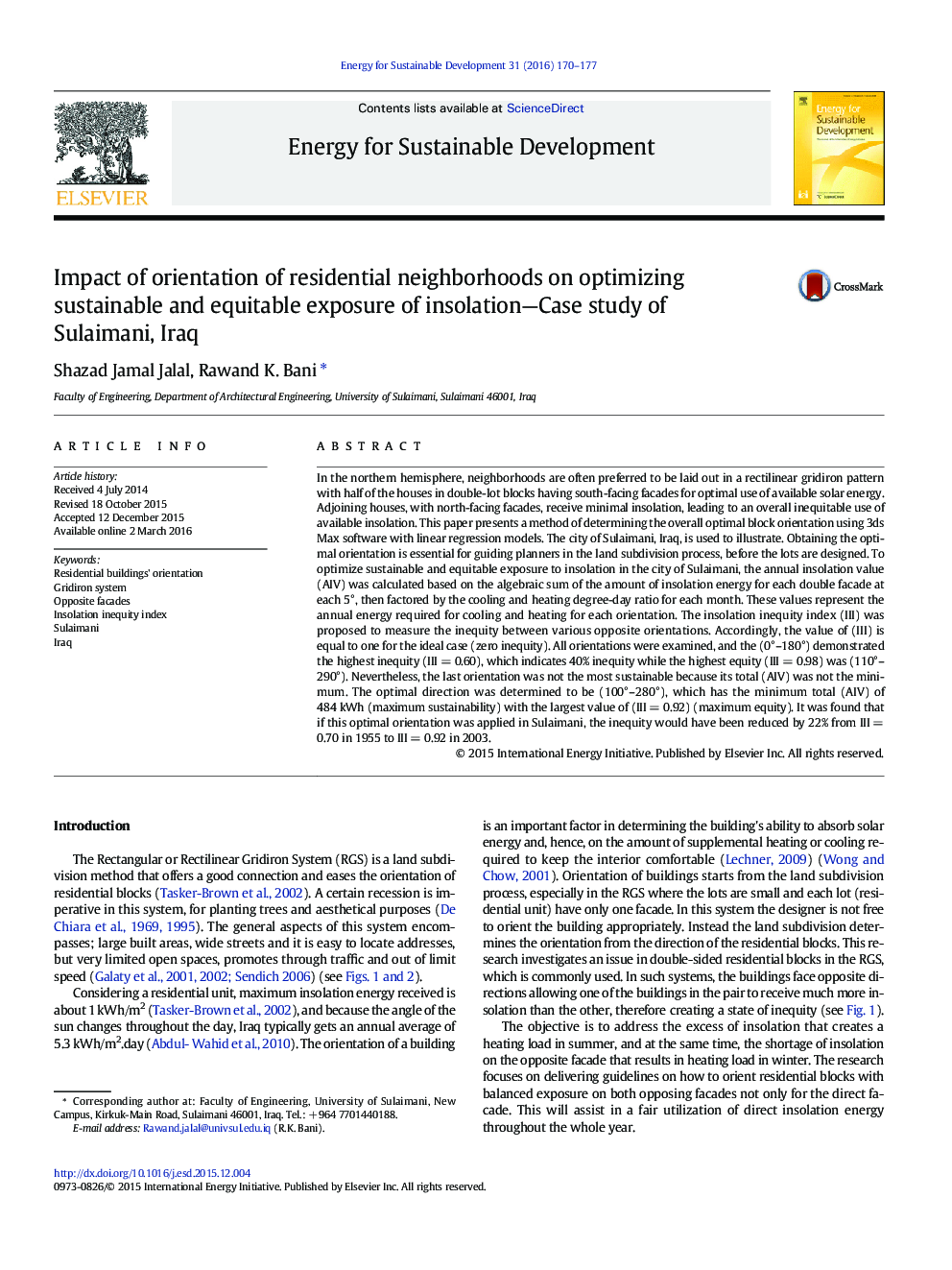| کد مقاله | کد نشریه | سال انتشار | مقاله انگلیسی | نسخه تمام متن |
|---|---|---|---|---|
| 1046817 | 1484399 | 2016 | 8 صفحه PDF | دانلود رایگان |
• In double-sided residential blocks in the Rectangular Gridiron System (RGS) the buildings face opposite directions allowing one of the buildings to receive much more insolation than the other creating a state of inequity.
• The annual insolation value (AIV) was calculated and factored using cooling (CDD) and heating degree days (HDD) ratios in each month to determine the overall lack or excess of insolation for each 5° orientation in Sulaimani, Iraq.
• An insolation imbalance index (III) was calculated from the AIV ratios of direct and opposite facades to evaluate the rate of inequity for each 5° double orientation in Sulaimani.
• The least III (0.60), maximum inequity, is of the due south–due north orientation and the maximum equity, highest III (0.98), is of 110°–290°, but this orientation is not the most sustainable of least total AIVs.
• The optimal orientation was determined to be 100°–280° of (III = 0.92) because it is the most sustainable (total AIV = 484 kWh) among the highest three IIIs found.
• In Sulaimani, the amount of inequity in the land subdivision was 0.30 (III = 0.70) in 1955 and decreased to 0.22 (III = 0.78) in 2003.
In the northern hemisphere, neighborhoods are often preferred to be laid out in a rectilinear gridiron pattern with half of the houses in double-lot blocks having south-facing facades for optimal use of available solar energy. Adjoining houses, with north-facing facades, receive minimal insolation, leading to an overall inequitable use of available insolation. This paper presents a method of determining the overall optimal block orientation using 3ds Max software with linear regression models. The city of Sulaimani, Iraq, is used to illustrate. Obtaining the optimal orientation is essential for guiding planners in the land subdivision process, before the lots are designed. To optimize sustainable and equitable exposure to insolation in the city of Sulaimani, the annual insolation value (AIV) was calculated based on the algebraic sum of the amount of insolation energy for each double facade at each 5°, then factored by the cooling and heating degree-day ratio for each month. These values represent the annual energy required for cooling and heating for each orientation. The insolation inequity index (III) was proposed to measure the inequity between various opposite orientations. Accordingly, the value of (III) is equal to one for the ideal case (zero inequity). All orientations were examined, and the (0°–180°) demonstrated the highest inequity (III = 0.60), which indicates 40% inequity while the highest equity (III = 0.98) was (110°–290°). Nevertheless, the last orientation was not the most sustainable because its total (AIV) was not the minimum. The optimal direction was determined to be (100°–280°), which has the minimum total (AIV) of 484 kWh (maximum sustainability) with the largest value of (III = 0.92) (maximum equity). It was found that if this optimal orientation was applied in Sulaimani, the inequity would have been reduced by 22% from III = 0.70 in 1955 to III = 0.92 in 2003.
Journal: Energy for Sustainable Development - Volume 31, April 2016, Pages 170–177
